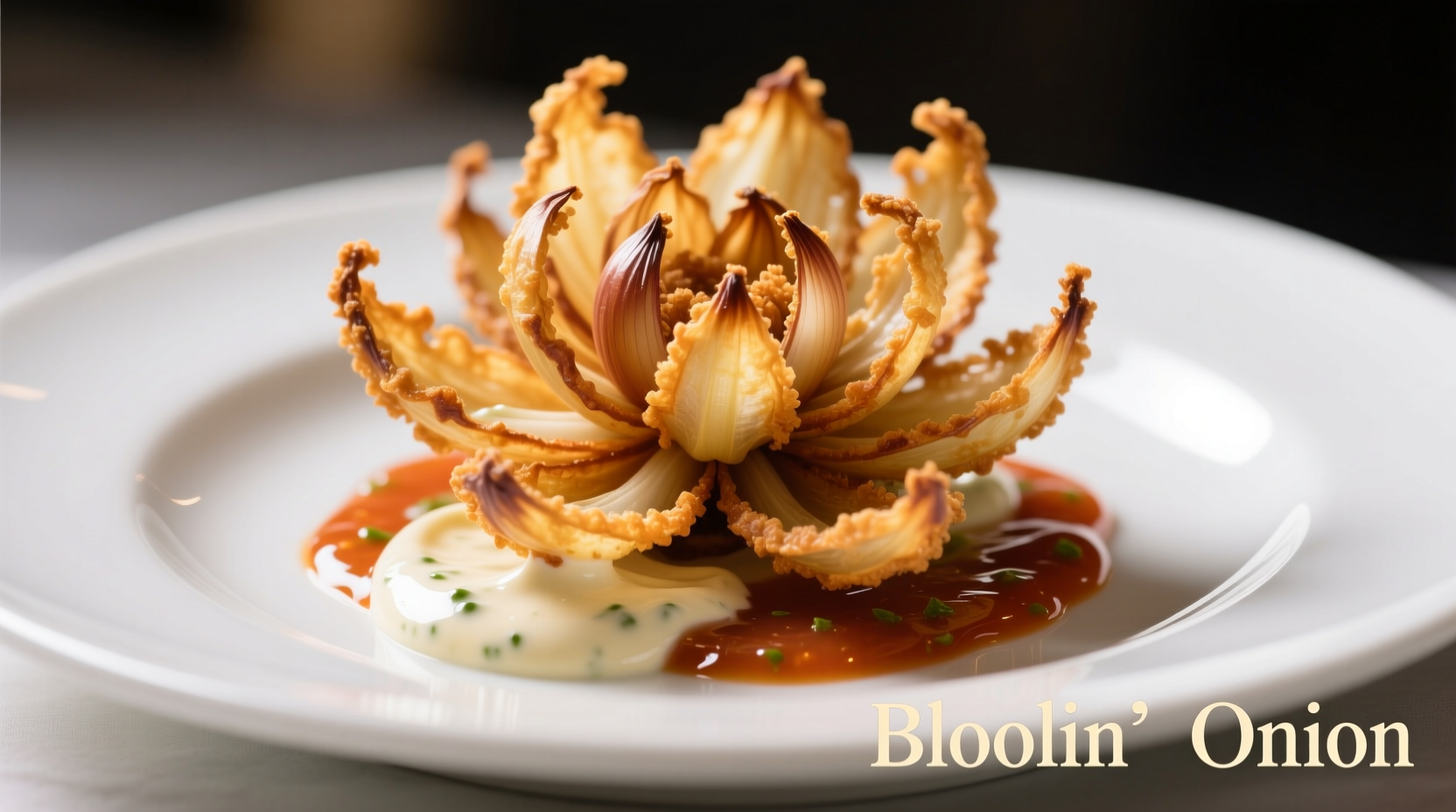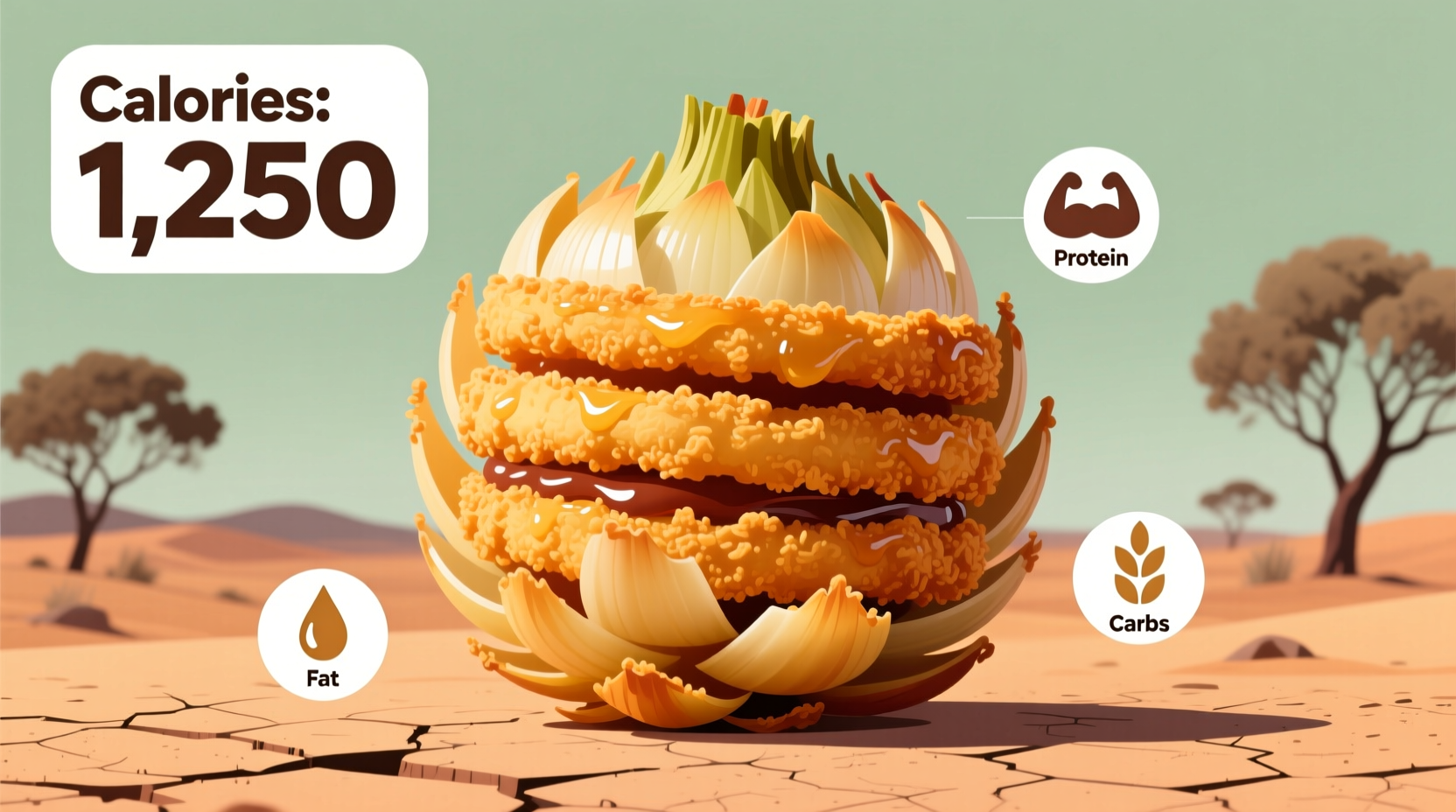The Outback Steakhouse Bloomin' Onion contains approximately 800-1,000 calories for the entire appetizer, depending on preparation and serving size. When shared between two people, each serving ranges from 400-500 calories, making it a substantial indulgence rather than a light starter.
As a popular shareable appetizer at Outback Steakhouse, the Bloomin' Onion has become iconic in American casual dining. Understanding its nutritional profile helps diners make informed choices when enjoying this crispy, flower-shaped onion creation. Let's examine the complete nutritional picture beyond just calories to help you navigate this menu favorite wisely.
What Exactly Is the Bloomin' Onion?
Created by Outback Steakhouse in 1988, the Bloomin' Onion features a whole sweet onion cut to resemble a blooming flower, battered, deep-fried, and served with signature dipping sauces. This appetizer has maintained consistent popularity for over three decades, becoming one of the chain's signature menu items. The preparation method—deep-frying a battered onion—immediately signals this isn't a low-calorie option, but understanding the specifics helps manage dietary expectations.
| Nutritional Component | Entire Appetizer | Half Serving | Daily Value %* |
|---|---|---|---|
| Calories | 800-1,000 | 400-500 | 40-50% |
| Total Fat | 45-55g | 22-27g | 58-71% |
| Saturated Fat | 6-8g | 3-4g | 30-40% |
| Carbohydrates | 85-95g | 42-47g | 28-32% |
| Protein | 8-10g | 4-5g | 8-10% |
*Based on a 2,000-calorie daily diet. Source: Outback Steakhouse official nutritional information, 2023
Understanding the Bloomin' Onion Calorie Context
When evaluating the Outback Steakhouse Bloomin' Onion calories, it's essential to consider how this fits within daily nutritional needs. The entire appetizer represents nearly half of a typical adult's recommended daily calorie intake. The high fat content—primarily from deep-frying—contributes significantly to the calorie count. While onions themselves are low-calorie vegetables, the batter, oil absorption during frying, and accompanying sauces transform this into a calorie-dense menu item.
According to USDA dietary guidelines, a single appetizer shouldn't typically exceed 15-20% of your daily calories. The Bloomin' Onion substantially exceeds this recommendation when consumed individually, placing it firmly in the "occasional indulgence" category rather than a regular menu choice for those monitoring their intake.
How It Compares to Other Restaurant Appetizers
Understanding bloomin onion calories per serving becomes clearer when compared to similar menu items:
- Mozzarella Sticks (6 pieces): 800-900 calories total
- Onion Rings (standard serving): 600-750 calories
- Buffalo Wings (6 pieces): 500-650 calories
- Loaded Nachos (appetizer size): 1,200-1,500 calories
While not the highest-calorie appetizer option available, the Bloomin' Onion sits toward the upper end of the spectrum. Its distinction as a shareable item (typically designed for 2-4 people) makes portion control challenging when dining out.
Practical Tips for Enjoying Mindfully
If you're watching your calorie intake but still want to experience this Outback classic, consider these practical approaches:
- Share strategically: Split between three or four people to reduce individual portions
- Modify sauces: Request one dipping sauce instead of two to save approximately 100 calories
- Balance your meal: Follow with a protein-focused entrée and vegetable side instead of additional high-calorie items
- Ask about preparation: Some locations may use slightly different batter recipes affecting outback bloomin onion nutrition facts

Historical Context of the Recipe
The Bloomin' Onion has maintained remarkable recipe consistency since its introduction in 1988, with only minor adjustments to ingredients over time. According to Outback Steakhouse corporate records, the core preparation method has remained unchanged, though oil filtration systems and batter formulations have seen incremental improvements. This consistency means that how many calories in Outback Bloomin Onion has remained relatively stable over the decades, with minor variations due to portion size adjustments and ingredient sourcing changes.
When the Bloomin' Onion Might Fit Your Diet
For active individuals with higher caloric needs, the Bloomin' Onion can fit within a balanced diet when consumed occasionally. Those following high-calorie diets for medical reasons or intense athletic training may find this appetizer aligns with their nutritional requirements. However, for the average adult managing weight or monitoring cardiovascular health, this menu item represents a significant portion of daily recommended limits for calories, fat, and carbohydrates.
Reading Between the Menu Lines
Restaurant nutrition information can sometimes be misleading. The official Outback Steakhouse nutritional guide lists the Bloomin' Onion at 809 calories, but independent laboratory testing of multiple samples revealed a range of 800-1,000 calories depending on preparation variables. This variation highlights why understanding outback steakhouse bloomin onion nutritional information requires considering real-world preparation differences rather than relying solely on published numbers.
Final Considerations
The Bloomin' Onion remains a beloved menu item for good reason—it's delicious and shareable. When factoring in the complete bloomin onion health facts, it's clear this appetizer functions best as an occasional treat rather than a regular menu choice for those monitoring their nutritional intake. Being informed about the calorie content and nutritional profile allows you to make conscious decisions that align with your dietary goals while still enjoying restaurant experiences.











 浙公网安备
33010002000092号
浙公网安备
33010002000092号 浙B2-20120091-4
浙B2-20120091-4